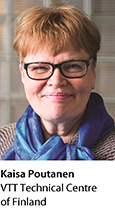 Q: What is your current position and what type of work do you do?
Q: What is your current position and what type of work do you do?
A: I am a research professor at VTT Technical Centre of Finland, leading our strategic area Food Economy 4.0 and developing technologies for a new consumer-centric sustainable food ecosystem in the digital era.
Q: When and how did you first decide you wanted to work in cereal grain science and whole grains?
A: Well, my grandfather had a wheat mill, so I may have been exposed already during my childhood. I actually started working with cereals a lot in the 1990s, after being appointed a research professor in food technology. The general motivation of my working life is to promote healthy eating and studying our national food, whole grain rye bread, brought me into the area of whole grains.
Q: How have you been involved with AACCI? How is AACCI viewed by whole grain scientists in the global community?
A: I do not really consider myself a “whole grain scientist,” rather a scientist who is working to use grains in the best possible way, i.e., for human food, including eating the outer layers and grain fiber complex as well! AACCI has been an active forum for discussion, especially concerning definitions relating to whole grain. I attended my first AACCI Annual Meeting in the early 1990s and most of the meetings thereafter. I realized that meeting was an excellent opportunity for networking, as well as for learning about the broad field of cereal grain science. I was a member of several committees, including the Scientific Advisory Panel. I also was a founding member, chair, and board member of the AACCI European Section, Cereals and Europe—it must be over 15 years ago now!
Q: What do you see as important issues shaping global research on whole grains? How are these issues affecting cereal science and the cereal grain industry overall?
A: The expansion of knowledge on the composition and structure of whole grains, as well as the epidemiology of their relevance in human health has been substantial. Research on biomarkers of intake hopefully will link population level work to intervention level work identifying better product attributes that are important for long-term health outcomes. I think we really need to consider consumer experiences and communication more in the future, as well as develop new product concepts, especially in the snack food categories. For oat, barley, and rye processing there are traditional uses as whole grains, but consumption is low compared with refined wheat products. We need to develop new technologies for including wheat bran in foods as well.
Q: This issue of Cereal Foods World focuses on carbohydrate quality. Do you have any perspectives on this topic?
A: I have given numerous lectures on this topic—it is not really about the quality of carbohydrates, but about their source, i.e., what comes with the carbohydrates! A carrot or apple is actually mainly sugar, if you look at the energy nutrients, but what makes them healthy is the consumption of water, vitamins, and fiber as part of the solid matrix of an enjoyable fruit. Carbohydrate quality is strongly dependent on nutrient density, e.g., eating more of the raw plant materials, rather than squeezing out and consuming only the pure carbohydrates.
Q: You were recently honored at the Whole Grain Summit for your leadership in whole grain research. Tell us about the award and what it means to you.
A: I received the Clyde H. Bailey Medal, the most prestigious ICC Award, for outstanding achievements in the service of cereal science and technology. Of course one feels honored when receiving an award, but also kind of embarrassed, as you do not work with awards in mind. I also feel honored to have had the opportunity to work with so many inspiring and nice colleagues, both at VTT and internationally, such as the HEALTHGRAIN Forum, and would like to share the distinction with them. In the end, it is working together that makes the career worthwhile.
Q: What’s next for you?
A: I am currently working quite a bit on new protein sources to valorize side-streams to produce new hybrid ingredients. These are plant ingredients that contain both fiber and protein and can be used in creating more nutritious foods. I am also very interested in personalized food delivery, extending the work from ingredient design to agile, automated production with digital interfaces that allow the consumer to become a prosumer, i.e., choose the kind of food they wish to be freshly produced at the point of purchase. On-the-go is also an expanding market with great potential for developing new kinds of healthy cereal-based foods.
